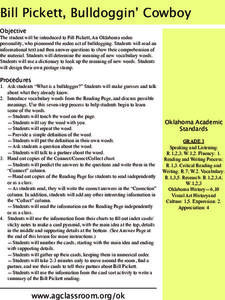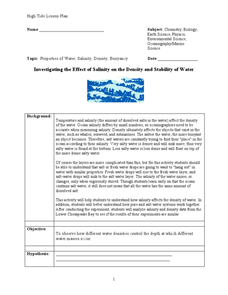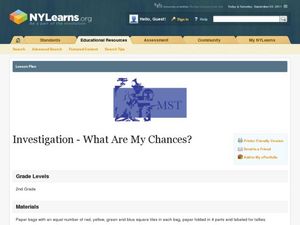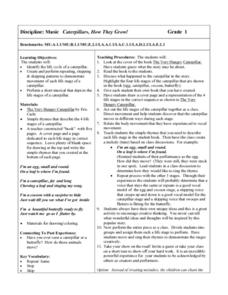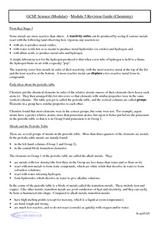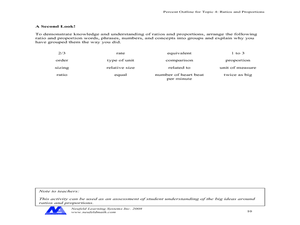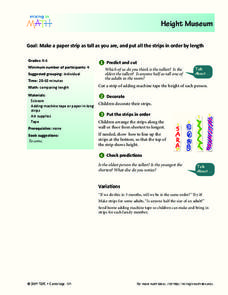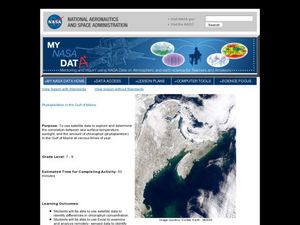Curated OER
Clay Heads
Sculpting can be a rewarding way to accent a instructional activity in any subject. This project requires learners to design and sculpt a head out of clay. The entire process is outlined in this resource; including photos and suggested...
Curated OER
Kites!
Let's go fly a kite! Little learners cut, glue, color, and design kites from a variety of materials. The step-by-step instructions are included along with three wonderful book recommendations. Tip: This project could easily be...
Curated OER
Greek Pottery Designs
Get creative while exploring the art and history of the ancient Greeks. Learners create construction paper representations of Greek pottery, focusing on the differences between geometric and organic shapes. This project could enhance an...
Teach Engineering
Glue Sticks Bend and Twist
Stick this resource in the "Use" column. In the second installment of a six-part series, learners use glue sticks to demonstrate forces. Using glue sticks, instructors can demonstrate tension, compression, and torsion.
Curated OER
Bill Pickett, Bulldoggin' Cowboy
Who was Bill Picket? Interested readers work through an informational passage to find out about a famous "bulldogger" from the old West. They answer several reading comprehension questions and use a seven step process to decode new...
Curated OER
Investigating the Effect of Salinity on the Density and Stability of Water
Water with varying amounts of dissolved salt are dyed and then used to compare densities. The objective is to discover the effect of salinity, and therefore density, on ocean water on the stability of the ocean. Many branches of science...
Curated OER
Investigation--What Are My Chances?
Seventh graders investigate theoretical and experimental probability by conducting a series of experiments with multiple trials, comparing results, combining results and making conclusions. They express probabilities as fractions,...
Curated OER
Jellybeans Up Your Nose
Jellybeans Up Your Nose, by Jeff Moss, prompts a discussion of responsible and irresponsible behaviors. After reading and discussing the poem, groups of fifth graders examine a Dr. Seuss-ism, from Geisel’s Seuss-isms, and report back to...
Curated OER
Word Search
Here is a word search that has more educational value than most. After finding the 14 words that have to do with natural resources, learners must then use the words in context. They answer 14 questions on the second page of the...
Curated OER
Music: Caterpillars, How They Grow!
Put on some music and get moving as a way to represent the life cycle of a caterpillar. Kids listen to the story The Very Hungary Caterpillar, discuss the life cycle, then create vocal expression that represent each stage of the cycle....
Curated OER
Land and People: Cape Cod Activity 1
Students make a model aquifer to study the uniqueness of Cape Cod's ground-water system. Using the model., they determine how easily contamination spreads in the aquifer system by completing and recording three activities. Using the...
Curated OER
Cycling of Matter and Energy
These twenty various types of questions related to the cycling of matter and energy require students to match each definition in column 1 with the correct vocabulary term from column 2. Then, students explain what is being demonstrated...
Curated OER
Balls & Hoops : Fun with Balls and Tubes
Students race to keep these balls rolling. In this early childhood physical education instructional activity, students experiment with cause and effect as they work with different heights of cardboard tubes.
Teach Engineering
Energy Forms, States and Conversions
Even magicians can't make energy disappear. In a discussion-based lesson plan, young scientists learn about energy forms and conversions. They see how energy is neither created nor destroyed; it just changes forms. This is the 11th...
Curated OER
Module 5 Revision Guide - Chemistry
If you use this as an outline for your chemistry lecture on metals, your young chemists will absorb a well-rounded overview. This is not a worksheet per se, but a useful summary of the behavior of metals. Save yourself some planning and...
Curated OER
The Clay Pot that YOU Built!
After listening to a story called The Pot that Juan Built about Mexican clay pot maker Juan Quezda, learners discuss this artistic process. Then, they discuss the special techniques used to make clay pots. And, finally, they make their...
Neufeld Learning Systems
Concept: Ratios and Proportions
Upper elementary and middle school pupils fill out a chart creating six equivalent fractions and then compare them to six different objects and/or shapes. They group together 16 various terms related to ratios and proportions. Pupils...
Curated OER
Height Museum
Here is an engaging lesson which invites learners to cut a strip of adding machine tape that is their height. They decorate their strip, arrange the strips from shortest to longest, and then discuss predictions.
Curated OER
Measuring Angles - Pretest Questions
Upper graders solve ten multiple choice problems about angles and measuring angles.
Curated OER
Role Models
First graders identify heroes by researching their family history. In this personal heritage lesson, 1st graders define the term "hero" and the characteristics that represent it. Students research family resources and family trees in...
Curated OER
Sequencing
Are you looking for a way to teach sequence of events in your narrative writing unit? Bring this lesson to your middle school class, as it prompts young writers to create a narrative sequence map of events that have happened at school...
Curated OER
Phytoplankton in the Gulf of Maine
Students use satellite data to see the correlation between sea temperature and sunlight in the Gulf of Maine. In this phytoplankton instructional activity students use Excel to analyze data.
Curated OER
Captions and Graphic Aides
Fifth graders read a book. For this informational text features lesson, 5th graders define captions and their purpose. Students view an article and discuss the graphic aides that assist comprehending the information...
Curated OER
Layers of Rock
Juvenile geologists drill clear plastic straws down into a playdough sedimentary rock model, pulling out sample rock cores. As they analyze their cores, they apply the law of superposition and discover that originally horizontal layers...




